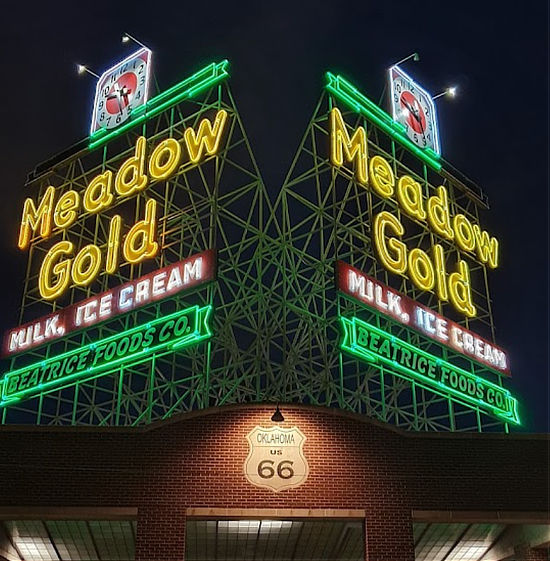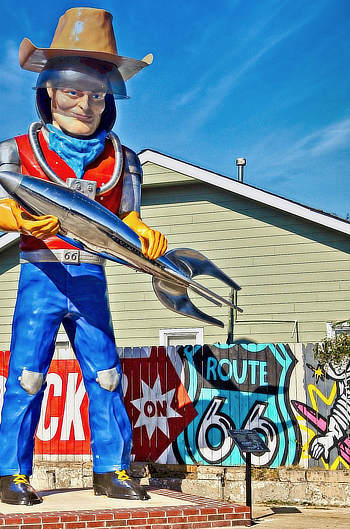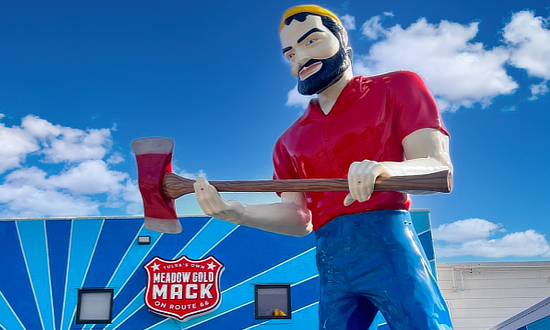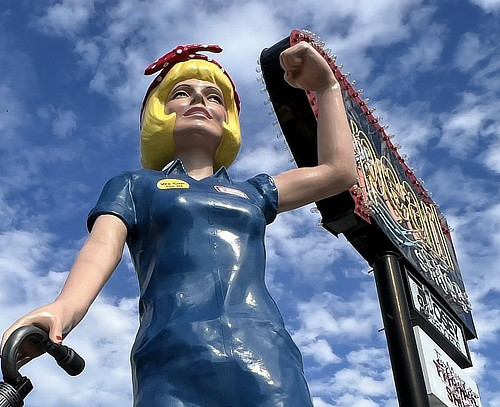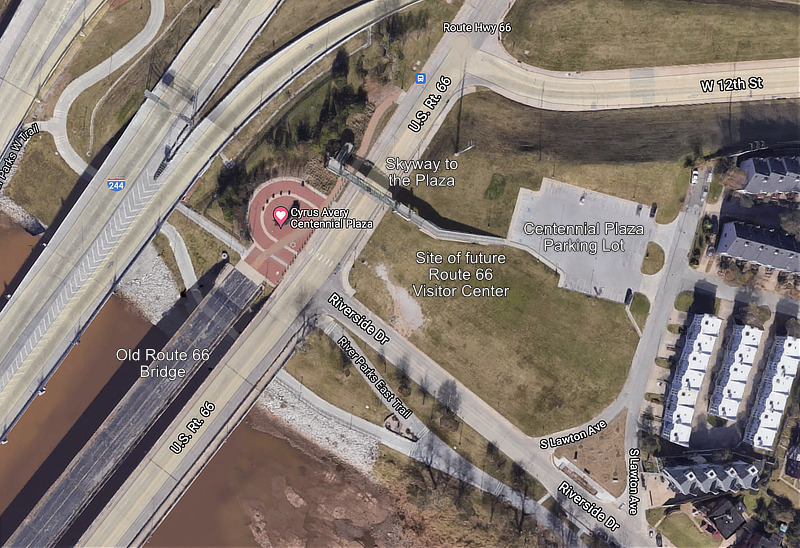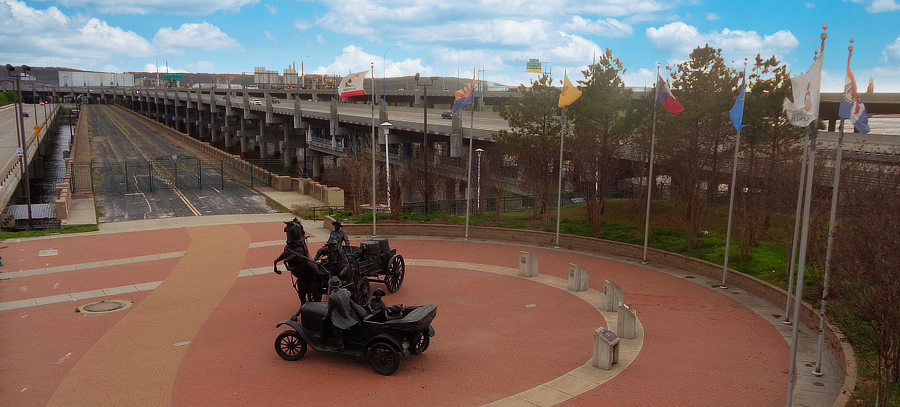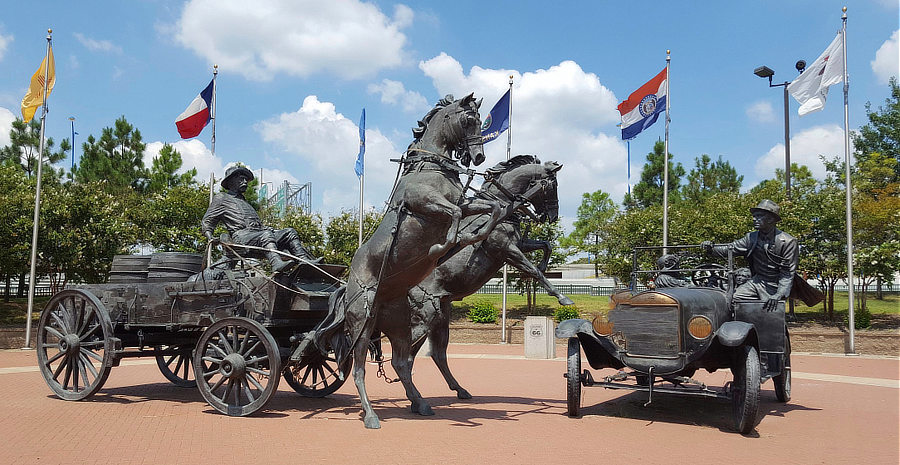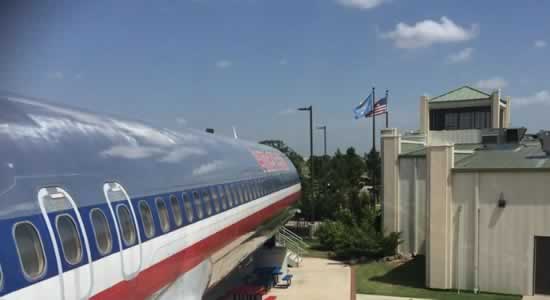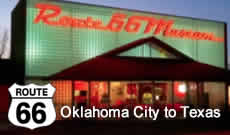Tulsa, Oklahoma Route 66 Travel Guide for 2026
 |
After traveling through Galena, Riverton and Baxter Springs, Kansas, Route 66 entered Commerce, Oklahoma, and headed southwest through Miami, Chelsea, Claremore and into Tulsa.
Once inside Tulsa, Route 66 traversed the city east-to-west on 11th Street into downtown, crossed the Arkansas River, and headed westbound to Sapulpa, Davenport, Chandler, Arcadia and Oklahoma City.
As other segments of Route 66, alignments around Tulsa varied and improved over the years.
In general, it followed the route of present-day Interstate I-44.
The city is known for its art deco architecture in the central Deco District. Landmarks like the Philcade and Philtower buildings reflect a 20th-century construction boom fueled by the prosperous local oil industry. It is often called "The Oil Capital of the World". The city is home to Oral Roberts University, the University of Tulsa and the University of Oklahoma - Tulsa.
Tulsa International Airport (TUL) is located about five miles northeast of downtown and provides non-stop flights to cities across the country. Also located at the airport is the global maintenance headquarters of American Airlines.
With 28 miles of The Mother Road, Tulsa is known as the Capital of Route 66 !
Map of approximate Historic Route 66 path through the Tulsa, Oklahoma area |
Lodging and Dining Options in Tulsa
|
Hotel listings and traveler reviews for Tulsa Tulsa Travel Guide |
Route 66 Capital Cruise
Tulsa is celebrating 100 years of Route 66 with the largest classic car parade ever. From vintage muscle to family treasures on four wheels, thousands of stunning cars will cruise right through the heart of the Capital of Route 66 ®. This exciting cruise will attempt to include 3,000 classic cars and become the largest ever on record. It will span 5.5 miles of Route 66 within Tulsa’s city limits. After staging at Tulsa’s Expo Square, cars will travel to the official start of the spectator route at 11th Street and Yale. The route will then follow 11th Street (Historic Route 66) just north of the University of Tulsa and through key intersections, including South Harvard, South Lewis and South Peoria, offering several high-visibility zones for spectators. Vehicles must be from 1996 or earlier, and must register in advance. More Info: Website Dates: May 30, 2026
|
||
Route 66 Road Fest
The Road Fest is a one-of-a-kind celebration giving you the chance to take your own journey through the history, attractions, characters, and fun of one of America’s most enduring treasures. It’s also a great opportunity to experience the Route itself. Make a weekend of it, and hit the road to explore some of the 400-plus miles of Route 66 that run through Oklahoma. More Info: Website and Facebook Dates: June 27-28, 2026 |
Highlights of the attractions to see in Tulsa
|
|
There are dozens of fun and interesting places to see and visit in Tulsa, both along and outside of Route 66.
Tulsa is an exciting, bustling city, an attractive destination for travelers.
The city offers a large array of museums, night life, events at the BOK Center, sports, lodging options and historic venues for visitors.
Tulsa has attractions ranging from trendy nightlife to first-class art museums, family fun destinations, shopping, Route 66 stops, and much more.
Listed below are but a few of the popular attractions in the Tulsa area.
Visit TripAdvisor for a full list of things to do in Tulsa along with travelers reviews
The Meadow Gold Neon SignAs the largest neon sign on Tulsa's landscape, the Meadow Gold sign is unique. With each face measuring 30 feet by 30 feet, the size and design of the Meadow Gold sign set it apart from all of the other signs that have been preserved and restored along historic Route 66. Erected in 1934, the Meadow Gold sign stood above its rooftop perch on 11th Street (Historic Route 66) for nearly seven decades and served as a reminder of days gone by - days of the milkman and deliveries of dairy products to the porches and front doors of Tulsa, and America. In August of 2004, the Tulsa Foundation for Architecture (TFA) applied for and received a grant from the Route 66 Corridor Preservation Program administered through the National Park Service to restore the Meadow Gold sign at its original location. It is located in the Meadow Gold District, at the corner of East 11th Street and Quaker Avenue. Read more at the Tulsa Market District website
|
Map of The Land of the Giants Along E 11th Street in Tulsa
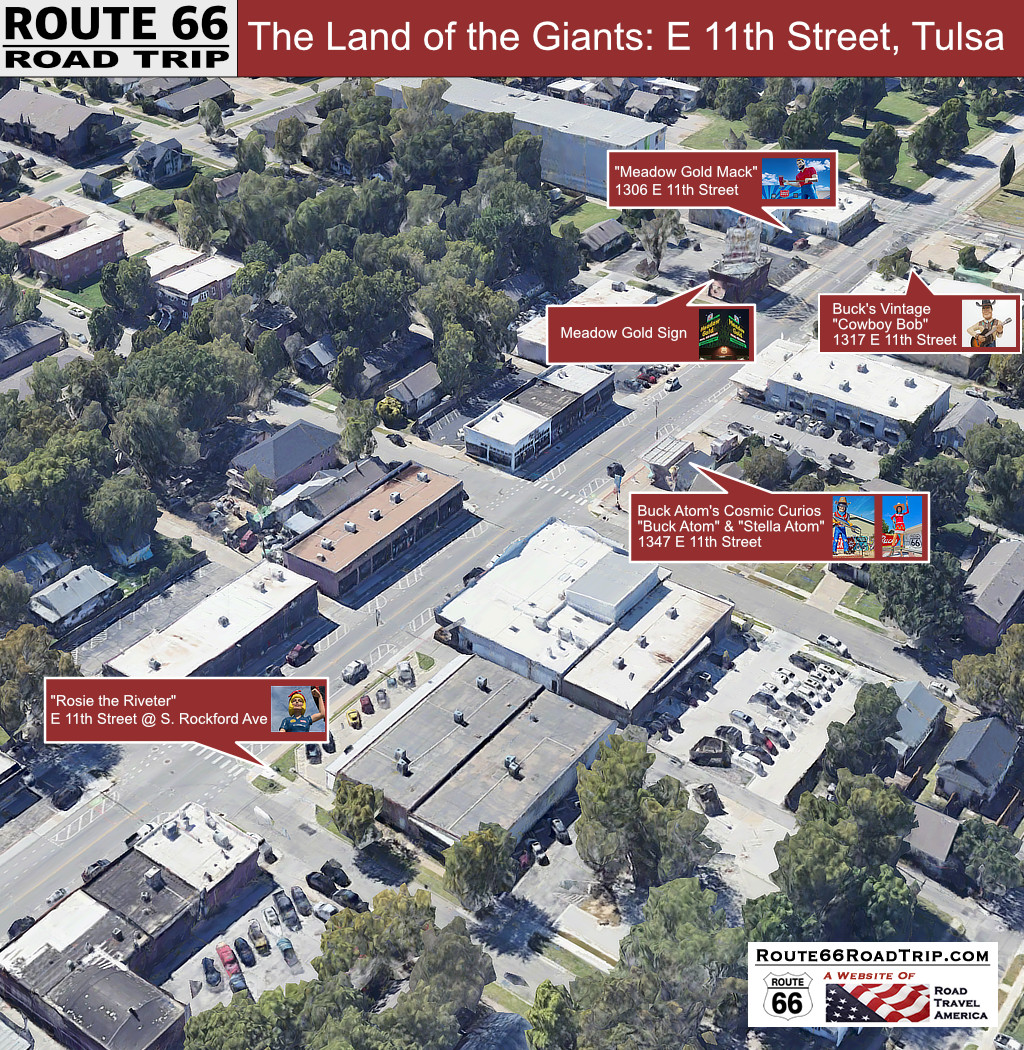 |
Buck Atom’s Cosmic Curios |
|
Buck Atom |
Stella Atom |
Located in a former site of a 1950s PEMCO gas station, Buck Atom’s Cosmic Curios on 66 welcomes visitors from all over to celebrate the magic of the Mother Road with apparel, toys, souvenirs, home accessories, art, jewelry and more. Stop by this unique retailer for a fun photo op with the 21-foot-tall Muffler Man, Buck Atom, space cowboy. On June 28, 2024, he was joined by Stella Atom, space cowgirl! These bigger than life figures are located at 1347 E. 11th Street in Tulsa. |
|
Meadow Gold Mack the Friendly LumberjackAnother "giant" has arrived in Tulsa! The grand opening for Meadow Gold Mack was held on August 24, 2024, at 1306 E. 11th Street. As part of the festivities, the area is celebrating a new 20-foot tall "muffler man" on Route 66 ... Meadow Gold Mack the Friendly Lumberjack. Meadow Gold Mack's Route 66 Outpost resides near the world renowned Meadow Gold neon sign on Route 66 in the heart of Tulsa. The Outpost features a cool variety of mini shops within one big space, with fun Meadow Gold Mack merchandise, vintage shops, plants, vintage books, ice cream, coffee, and much more! When in Tulsa, be sure to stop and shop in the store, or shop online at the Meadow Gold Mack Store For more information and news, visit the Meadow Gold Mack Website and Meadow Gold Mack on Facebook
|
Cowboy Bob at Buck's Vintage on 66Near Buck Atom's Cosmic Curios along 11th Street is Buck's Vintage, a curated Western vintage shop. It is located at 1317 East 11th Street, in the 66 Collective. Shop an extensive line of clothing, home decor, accessories, jewelry, books and more! At the new location, Buck's welcomed a new 20-foot tall giant, named Cowboy Bob, on August 14, 2025! Read more, and shop online, at the Buck's Vintage Website ... also Buck's Vintage on Facebook and Instagram
|
Rosie the RiveterThe Land of the Giants welcomed 19-foot tall "Rosie the Riveter" on Thursday, October 2, 2025, just west of Ike's Chili. Mary Beth Babcock, the owner of Buck Atom's, had the giant commissioned and says Rosie the Riveter is based on Naomi Parker Fraley, who was born in Tulsa and inspired the "We Can Do It!" poster. Rosie is located on East 11th Street at the corner of South Rockford Avenue. Rosie the Riveter to be installed at the Land of the Giants on Route 66 October 2
|
Read more about Giant "Muffler Men" Along All Eight States of Route 66 |
Ike's ChiliIke's Chili is the oldest known Oklahoma restaurant, established in 1908. Today, it is located on Historic Route 66, at 1503 East 11th Street, in the Meadow Gold District. Ike's advertises that it is the "best place to have a three-way in the USA" ... spaghetti, beans and chili. It also offers a variety of chili dishes, burgers, sandwiches and sides. For more information, phone 918.838.9410, and visit the Website of Ike's Chili and Ike's Chili on Facebook |
|
 |
 |
The Golden Driller in Tulsa
The Golden Driller is a 76-foot, 22-ton statue of an oil worker in Tulsa, located outside the Tulsa Expo Center. It is the 6th tallest statue in the United States. The plaque at the base reads "The Golden Driller, a symbol of the International Petroleum Exposition. Dedicated to the men of the petroleum industry who by their vision and daring have created from God’s abundance a better life for mankind." Located at 4145 E. 21st Street in Tulsa. |
"You Said We Couldn't Do It" MuralThis mural commemorates a bridge built over the Arkansas River in Tulsa in 1904. The bridge wasn’t for rail traffic, so investors considered it a risky project. The government wouldn’t pay for it either. Instead, three citizens formed a toll company and paid for the bridge, a huge undertaking both financially and logistically due to the shifting river bed. On the completed bridge they hung a sign, “You Said We Couldn’t Do It, But We Did.” Located in the Meadow Gold District - 1306 E. 11th Street at S. Peoria Avenue
|
The Cyrus Avery Centennial PlazaTwo plazas in Tulsa celebrate Historic Route 66 and Cyrus Avery: Centennial Plaza on the east bank of the Arkansas River, and Southwest Plaza on the west bank. Map showing the key elements of the Cyrus Avery Centennial Plaza
A Skyway with observation deck leads pedestrians from the visitors parking lot across Southwest Boulevard to the plaza.The park and sculptures are an artistic representation of the use of automobiles and highways spreading across the country in the late 1920s and 30s. Centennial Plaza is located at the east entrance to the historic bridge at the intersection of Southwest Boulevard and Riverside Drive. A visit to Centennial Plaza is highly recommended for Route 66 fans!
|
||
View of Skyway looking west |
View of bridge from Skyway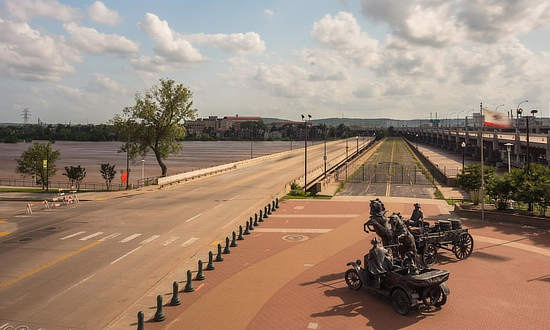 |
|
| Observation walkway under I-244, looking east, old Route 66 bridge & Skyway to the right |
||
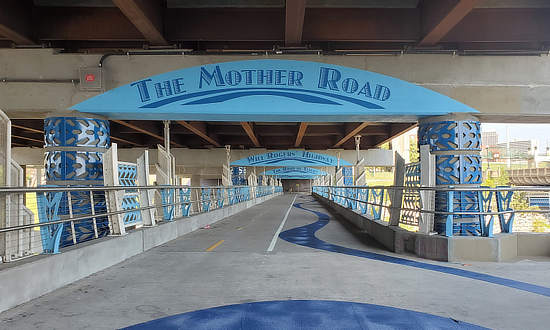 |
||
The Sculptures
|
|
Route 66 Bridge Over the Arkansas RiverDirectly west of Cyrus Avery Centennial Plaza is the original Eleventh Street Bridge bridge built in 1915 to carry Route 66 over the Arkansas River. It is located between newer bridges on Southwest Boulevard and Interstate 244, and was closed to traffic in 1980 although it remained open for pedestrians for a time. Gates were locked on the bridge in 2008, and it remains closed to both vehicular and pedestrian traffic today. The old bridge is listed on the National Register of Historic Places and re-named the Cyrus Avery Route 66 Memorial Bridge. |
|
 |
 |
The Cyrus Avery Southwest PlazaThe Cyrus Avery Southwest Plaza is located near the west side of the historic Route 66 bridge.The plaza includes replicas of three neon signs from classic Tulsa-area motels: Tulsa Auto Court, the Will Rogers Motor Court, and the Oil Capital Motel (see photos below). |
|
Will Rogers Motor Court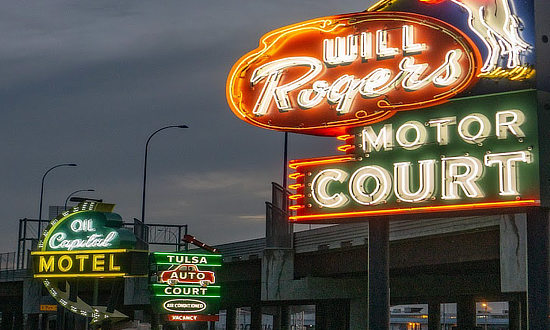 |
|
Tulsa Auto Court |
Oil Capital Motel |
Other Attractions Around Tulsa
 |
Mother Road MarketTraveling down historic Route 66 and looking for a place to stop? Visitors will find a variety of places to eat and shop at Tulsa’s first food hall, The Mother Road Market. Browse local gift items, buy fresh produce and pick from unique restaurant options. Located at 1124 South Lewis Avenue in Tulsa. |
|
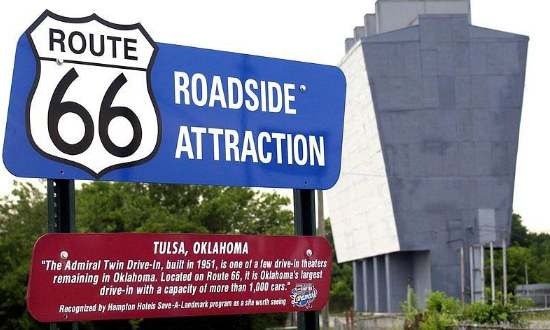 |
Admiral Twin Drive-inBuilt in 1951, this is one of a few drive-in theaters remaining in Oklahoma. It is the state's largest drive-in, with a capacity of more than 1,000 cars. |
|
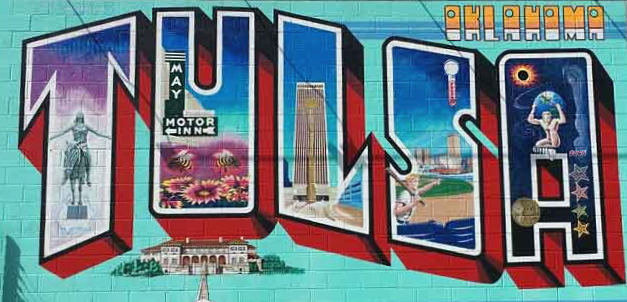 |
Tulsa MuralsTulsa has a large number of exceptional murals, such as this "Tulsa Vintage Postcard" mural. |
|
102 E. Reconciliation Way |
Woody Guthrie CenterThe Center honors Woody Guthrie’s life and legacy by educating visitors about his relevance today and his important role in American history. |
|
1400 N. Gilcrease Museum Road |
Gilcrease MuseumThis popular museum houses the world’s largest and most comprehensive collection of art and artifacts of the American West. |
|
|
Tulsa Botanic Garden3900 Tulsa Botanic Drive, 8 miles northwest of downtown Tulsa |
|
2727 S. Rockford Road |
Philbrook Museum of ArtThe Philbrook Museum of Art is housed in an Italianate villa that was once the home of a local oil magnate. |
|
 |
BOK Center200 South Denver Avenue West |
|
Boston Avenue Methodist ChurchCompleted in 1929, the Boston Avenue Methodist Church is considered one of the best examples of ecclesiastical Art Deco architecture in the United States, and has been placed on the National Register of Historic Places. |
Located at 1301 South Boston, in Tulsa |
CityPlex TowersCityPlex Towers is a complex of three high-rise office towers located at 81st Street and Lewis Avenue in Tulsa. |
The complex was originally constructed by Oral Roberts University as the City of Faith Medical and Research Center and meant to be a major charismatic Christian hospital. The tallest tower is 60-stories in height. |
The Healing Hands sculpture, on the campus of Oral Roberts University in Tulsa
It is the largest bronze sculpture in the world, and towers 60-feet high.

Tulsa Air and Space Museum & PlanetariumThe museum is located near the Tulsa International Airport and features a series of historical aviation exhibits, hands-on activities, and vintage aircraft. |
A full-dome planetarium was added in 2006. |
Route 66 Historical VillageThis open-air museum is a unique experience to educate visitors about Tulsa's history in the oil, refining and transportation industries. The Visitor’s Center is a replica of a 1920’s Phillips 66 gas station. The tallest oil derrick in North America is a favorite with visitors. Located at 3770 Southwest Boulevard. |
|
 |
 |
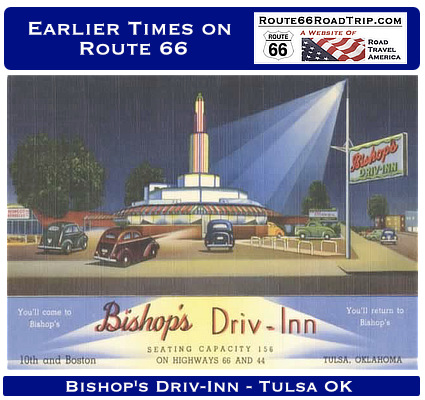 |
Earlier Times on Route 66: Vintage Views of Tulsa
What was Route 66 like in its earlier years, as visitors drove around or through Tulsa? What did all the service stations, motels and public buildings look like when they were new?
What did the traveling public experience on the Mother Road? We wonder such things when we travel Route 66 today.
Those earlier times in the 1930s, 40s and 50s were not always captured on film. But the use of colorful postcards was common in those decades.
We have included below a sampling of our collection of vintage travel postcards showing scenes in Tulsa. These portray the city in its earlier years and help us to visualize "yesterday" as we drive Route 66 today.
Will Rogers Motor Court |
Bordens Restaurant |
Cooks Court  |
Anchor Court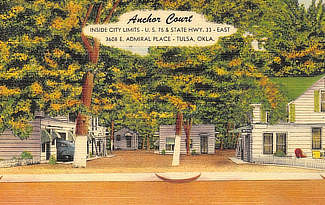 |
Little Mexico Restaurant |
Downtown Motel 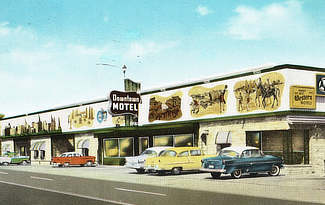 |
Interactive Map of Tulsa Oklahoma
Route 66 Road Trips in Oklahoma |
|
MORE OKLAHOMA ROUTE 66 |
||
 |
 |
 |
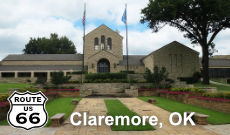 |
 |
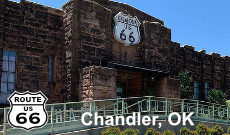 |
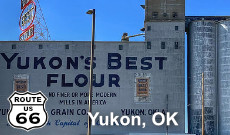 |
 |
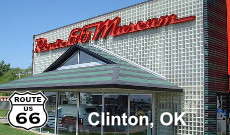 |
 |
 |
 |
 |
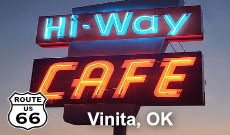 |
 |
Travel Guides for Other States Along Route 66
Planning a Road Trip on Route 66? Here are trip planners for all eight states on The Mother Road ...
 |
 |
 |
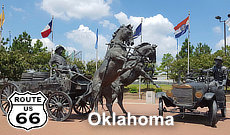 |
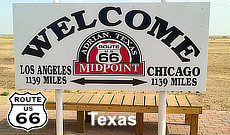 |
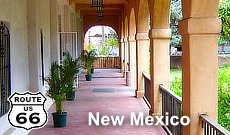 |
 |
 |
More About Tulsa
Tulsa Convention & Visitors Bureau
More Things to Do on Route 66 - at the Oklahoma Tourism Department






